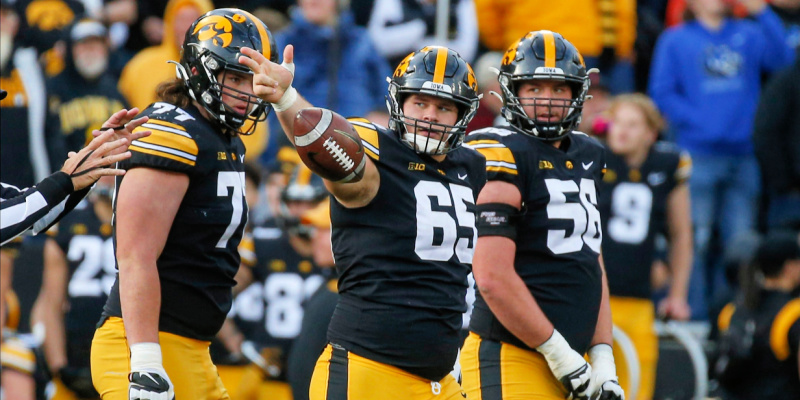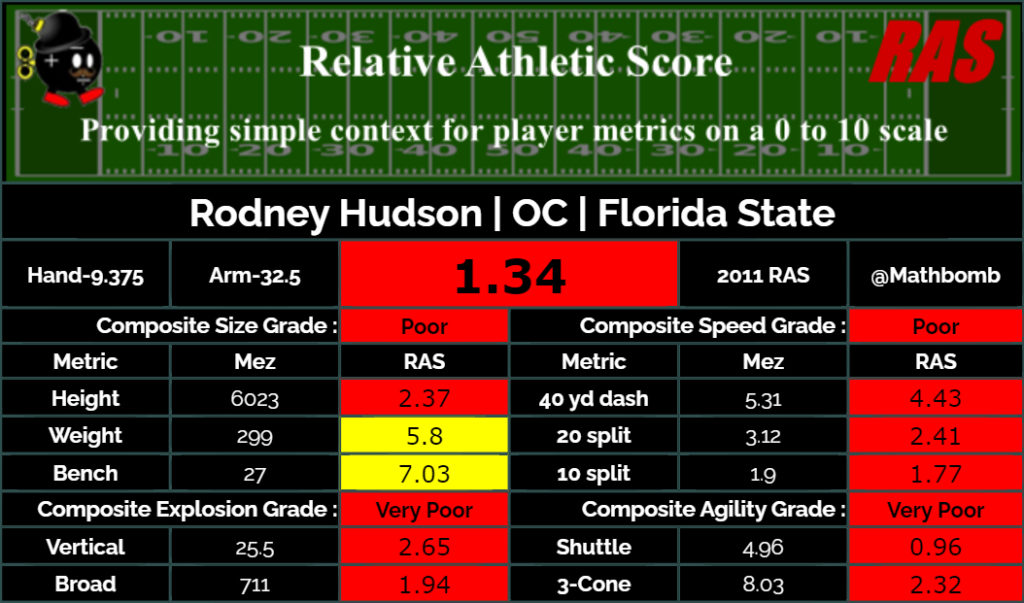Analysis
4/7/22
8 min read
The Price is Wrong? - Do NFL Teams Undervalue the Center Position?

Man's best friend.
Upon reading those words, you probably immediately thought dog, but what would be your first instinct when pressed for the identity of the best friend of a young quarterback.
A dominant receiver? A stud left tackle? An elite running back to take the strain off the passing game?
Each of those answers may have come to mind. But ask that question in NFL front offices and it is likely that plenty would have the same response: the center.
It's not a position casual observers think about much but, for quarterbacks just making their way in the NFL, there is no better ally than an intelligent center who can read defenses, call out and change the protections, identify and pick up blitzers and make an impact in the running game.
As former Detroit Lions president Tom Lewand explains: "The center position is critical, especially for a young quarterback.
"A good center who can handle the position physically provides the ability to allow a young QB to develop NFL pocket presence, particularly the ability to step up with A gaps being secure. More important, a center who can also handle protections and run game checks can slow the game down for most young QBs faster than it will happen naturally. Smart teams recognize that value and pay accordingly."
Given the level of responsibility on the shoulders of the center, there would appear to be a strong argument for it being considered a 'premium' position in the NFL. Yet there is no doubt it is not treated as such.
Prior to the 2021 draft – when Landon Dickerson was the first center off the board in the second round – there had been a center taken in the first round of the draft in five of the previous six classes. However, not since Steve Everitt was selected by the Cleveland Browns with the 14th pick in the 1993 draft has a center gone in the top 15.
Center contracts also lag well behind those handed to the players who play the consensus non-quarterback premium positions of edge rusher, offensive tackle and cornerback.
But with so many teams staking their future on prospects coming off the production line of quarterback talent entering the league, the case can be made that the center position has never been important in the NFL. So, have we reached a point where the center position is undervalued?
No premium paid
At the time of writing, 26 free agents had been signed to contracts with an average annual value of at least $10 million since the start of the new league year. None of those players were centers.
Prior to free agency, Ryan Jensen signed a three-year, $39 million deal to remain with the Tampa Bay Buccaneers, while Jason Kelce became the league's highest-paid center, signing a one-year $14million pact to remain with the Philadelphia Eagles.
The largest contract handed out to a center to hit the market was given to Ted Karras, who signed a three-year, $18 million deal with the Cincinnati Bengals. Bradley Bozeman, regarded as one of the top centers on the market, signed a one-year deal with the Carolina Panthers for just $2.8 million.
Compare Kelce's deal to the top contracts at wide receiver (Tyreek Hill, $30 million), edge rusher (T.J. Watt, $28.02 million), tackle (Trent Williams, $23.01 million) and cornerback (Jalen Ramsey, $20 million) and an illustration of the gulf in how center is valued in contrast to the premium positions is clear for all to see.
Over The Cap's look at the average salary per player, with rookie deals and street free agent contracts removed, offers a more favorable picture of center value. With centers earning on average $6.37 million, the position ranks only a tick below cornerback ($7.12 million) but is still eighth on the list out of the 12 non-kicking game roles.
The compensation does not appear to match up with the importance centers hold to NFL gameplans and quarterbacks making their way in the league. Why is that the case?
Athletes preferred, but not required
Frustratingly for a position where so much is asked of the player, it is the attributes required to carry out those responsibilities that are a primary reason why centers are not as well paid as their contemporaries at other positions.
Zone-blocking centers must show the athleticism to climb to the second level of the defense in the run game but, for the most part, a center's success is not predicated on his physical gifts. It is their awareness and ability to communicate that are paramount in ensuring the quarterback is successfully protected.
Take, for example, the Relative Athletic Scores (RAS) for some of the elite centers in the modern era. RAS assigns scores for a draft prospect's measurements and performance in athletic testing based on what percentile they fall in for their position and averages each of those scores to give the player a final number on a 0 to 10 scale.
Five-time Pro Bowler Travis Frederick posted a RAS of just 2.6, three-time first-team All-Pro and nine-time Pro Bowler Maurkice Pouncey's RAS was 4.69 while for Rodney Hudson, another three-time Pro Bowler, it was only 1.34.

The current elite performed much better athletically. Kelce, still the class of the league at the position, had a RAS of 9.5 and has been named first-team All-Pro in four of the last five seasons. Corey Linsley, first-team All-Pro in 2020, posted a RAS of 9.19, while 2020 second-team All-Pro Frank Ragnow, whom Kelce displaced as the highest-paid by average annual value, recorded an exceptional 9.93.
With Linsley's contract with the Chargers worth $12.5 million annually, it is clear teams are willing to pay up for centers who offer that athletic upside. However, because it is not a pre-requisite for success at the position, franchises dedicate greater resources to areas where athleticism is a more significant part of the equation.
A 2022 draft class loaded with athletic prospects at center could reveal just how highly the league values centers who possess comparable physical attributes to those who make up the highest-paid players at the position.
Draft class depth
The 2022 center class is reflective of this draft overall. It has depth yet there are questions about the guy at the top, with some suggestions Iowa's Tyler Linderbaum is set to slide down the board.
Pro Football Network's Tony Pauline cited doubts over his abilities as a power blocker and concern over his measurements at the Combine, where his arm length was measured at 31 1/8 in, in the first percentile for offensive linemen, as reasons for talk over Linderbaum falling out of round one.
Where will Tyler Linderbaum end up in the draft?
SCOUTING REPORT➡️https://t.co/aeElc8DiF8 pic.twitter.com/ISXOCGdu3X
— The 33rd Team (@The33rdTeamFB) April 5, 2022
Should that scenario come to pass, then it would suggest the rest of the NFL has not learned its lesson from letting Creed Humphrey fall into the lap of the Kansas City Chiefs in the second round last year.
Humphrey was named to the All-Rookie Team last year and, as an extremely efficient mover in space who excels at picking up extra blitzers and is unafraid to bring some to thud to proceedings, there is little reason for Linderbaum to follow in his footsteps in falling into round two.
An excellent athlete and well-rounded prospect whose position of seven on the 33rd Team big board indicates he is a sure-fire first-round selection, whether Linderbaum's fall down the board happens could be viewed as a litmus test for how the NFL values its centers.
However, his potential draft-day slide may be influenced by teams being willing to wait longer to snag one of the several superb athletes who can play center in his draft.
Indeed, the number of centers that go in the top 100, rather than the final draft slot of Linderbaum, might offer a better indication of the position's standing in modern NFL front offices.
Kentucky's Luke Fortner, another smooth mover in space who also demonstrates impressive lateral quickness, is the 49th prospect on The 33rd Team big board, while Cole Strange (56) and Dylan Parham (100) are also in the top 100 and possess guard-center versatility. Strange posted an outstanding RAS of 9.95 while Parham earned an impressive 8.75 for his pre-draft workout.
Nebraska's Cam Jurgens (RAS: 9.94) and Alec Lindstrom of Boston College (8.75) also offer intriguing athletic ability for teams looking to address the heart of the offensive line.
The 2018 draft marked the only time since 2010 that six centers have gone in the first 100 picks. There is the talent in this class to change that and, though the financial compensation offered to free agents appears unlikely to markedly improve anytime soon, the potential investment in a crop of rookies whose physical skill sets match up well with those of the highest-paid centers in the NFL may more accurately reflect the pivotal role the position plays in offensive success.








